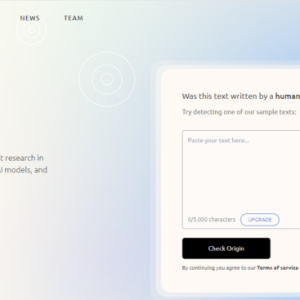Welcome to ChatGPT for Beginners: Your Quick & Easy Guide to Mastery! ChatGPT, developed by OpenAI, is a cutting-edge language model that has revolutionized the way we interact with artificial intelligence. Whether you are a student, professional, or simply curious about AI, this guide is designed to help you navigate the world of ChatGPT and unlock its full potential. In this comprehensive tutorial, we will walk you through the basics, including how to get started, best practices for engaging with the model, and tips to achieve mastery in your conversations. Get ready to embark on an exciting journey as we delve into the endless possibilities of ChatGPT!
Boom! You’ve caught wind of ChatGPT, and you’re fired up to join the AI revolution. Guess what? You’ve struck gold! Today, we’re delving deep into the “ChatGPT for beginners” topic.
You are viewing: ChatGPT For Beginners: Your Quick & Easy Guide to Mastery
I’ll break it down piece by piece, so even the greenest of ChatGPT neophytes can harness its potential.
So grab your gear, my friend, as I lead you on a quest to conquer ChatGPT and emerge a true whiz!
How to Create an Account with ChatGPT?
Getting started with ChatGPT is super easy (and is one of the drivers of the incredible rise of ChatGPT’s growth)! Here’s what you need to do:
Go to the ChatGPT starting page and look for the “Sign Up” button.
Enter your email address and create a strong password. You also need to agree to the terms and conditions.
Check your email and confirm your account.
And just like that, you’re all set to start exploring the world of ChatGPT!
ChatGPT Capabilities
ChatGPT, the advanced AI language model based on GPT-4, offers remarkable capabilities, such as:
- Language understanding: ChatGPT will grasp context, sentiment, and nuance for sophisticated dialogues.
- Top text generation: Creates high-quality, diverse content for various applications.
- Multilingual skills: Bridges language gaps.
- Zero-shot learning: Tackles new tasks without prior examples.
- Integration: Works with other tech to enhance user experiences and streamline processes.
- Text/image parsing: Understands both textual and visual inputs.
In other words, it’s smart as hell. It’s even passing GRE, US legal, and medical exams.
GPT-4 is even more advanced than its predecessor, GPT-3.5.
While GPT-3.5 was already an impressive machine learning model that could pass the bar exam, it only scored in the bottom 10%.
GPT-4 takes things to the next level by achieving a top 10% on the bar.
Read the full GPT-4 technical report.
ChatGP Limitations
Although ChatGPT is a powerhouse language model, now and then, it might hit a speed bump.
ChatGPT sometimes “hallucinates” information, producing plausible but incorrect responses. These can occur when the AI doesn’t have enough accurate information to answer a question or misunderstands the context.
Open AI also implemented “guardrails” that prevent the AI from generating harmful or offensive content. As a result, ChatGPT will steer clear of any controversial or unsavory content.
Next, don’t forget about social biases. Since ChatGPT is trained on vast amounts of data from the internet, it inadvertently learns the social biases present in that data.
OpenAI CEO Sam Altman acknowledged some of these shortcomings:
What Types of ChatGPT Prompts Can You Use?
Looking to create compelling content with ChatGPT? You can use many types of prompts to inspire your writing, including prompts for:
- Generating ideas
- Solving problems
- Crafting content
- Creating outlines
- Summarizing text
- Reverse engineering text (into ChatGPT prompts)
- Organizing data
Ideation
See more : Wordtune Review | Pros, Cons, Alternatives, and Pricing
Looking for fresh ideas? ChatGPT can generate topics for your SEO or tech blog posts.
Example: “Suggest topics related to mobile SEO best practices.”
ChatGPT might offer ideas like “The Importance of Mobile-First Indexing in SEO” or “Optimizing Page Load Speed for Better Mobile SEO Performance.”
Problem-Solving
ChatGPT can help you tackle challenges. For example, I asked ChatGPT to solve one of the world’s most pressing challenges:
“How would you solve the massive challenge of natural resource depletion as the world’s population continues to grow, which puts a strain on resources and the environment?”
Long-Form Content Creation
Generate comprehensive long-form content by providing context.
Instruct ChatGPT: “Write a 1000-word guide on implementing structured data for SEO.”
One major issue is that when you ask ChatGPT for an extremely long output based on a short input, you give up control of the writing process.
- The quality of the output may vary
- It might contain inaccuracies
- It lacks the personal touch that comes from writing something yourself.
So, always remember:
- Consider the input-to-output ratio.
- If the inputs are vague, the outputs will be surface-level.
I’m not saying that Google penalizes generative ai content (they don’t!). But don’t take that as a free pass to churn out robotic articles that lack depth or personality.
Remember, Google’s algorithms crave value, originality, and authenticity.
Bottom line: quality still reigns supreme. Use AI wisely, and you’ll strike gold with your content.
Outlines
ChatGPT can create outlines for SEO or tech projects. (We also cover how to use ChatGPT for SEO).
Example: “Outline a blog post on cybersecurity best practices for small businesses.”
ChatGPT will provide a clear structure with headers like “Understanding Cyber Threats” and “Implementing Cyber Security Best Practices.”
Content Summary
ChatGPT can summarize lengthy documents for you (check out more detailed info on how to use ChatGPT to summarize an article).
Example: “Summarize the key points from this Al Jazeera article on GPT-4 [URL].”
It will generate a concise summary highlighting the key points and findings (and also check out our list of summarize generator tools).
Reverse Engineering Text
Have you ever encountered a piece of writing you wish to replicate? Reverse engineering text with ChatGPT involves breaking down the writing into a prompt that you can feed into the AI system.
This prompt can include information about the writer’s style, tone, structure, and any other details you want to emulate.
“[Instructions] I want you to take this [URL] and break it down into a prompt formula I can use for ChatGPT. You should provide:
- [context]
- [specificity]
- [tasks]
- [tone]
- [style]
- [main objectives]
Take the variables above and craft a detailed and cohesive ChatGPT prompt I can use as context before I write my article.
Do you understand? Don’t write anything yet.”
See more : The Ultimate Guide to AI for Bloggers
Next, drop ChatGPT your URL.
ChatGPT will provide an excellent starting point for writing your article.
Remember, inputting the prompt directly into ChatGPT might not produce the most original results.
To make sure your output is distinctive, consider these tips to modify your prompts:
- Introduce a twist: Change the prompt to encompass a unique angle or viewpoint. You could, for instance, concentrate on specific industries related to your topic.
- Personalize the experience: Tailor the prompt by incorporating your personal experiences or opinions. Share any wisdom or lessons you’ve gained along the way.
- Elaborate on tasks: Dissect the tasks into smaller components, adding concrete examples or case studies. This encourages ChatGPT to deliver more comprehensive and varied information.
- Pose questions: Embed questions within the prompt to stimulate thought and encourage further exploration. For example, ask, “Can you think of any unexpected ways ChatGPT might assist companies in boosting their email open rates?”
Reports/Tables
Impress your audience with AI-generated reports and tables. ChatGPT can process data and present it in a visually appealing, organized manner.
Provide the AI with the necessary data, such as:
“Create a table comparing the capabilities of GPT-3.5 and GPT-4.”
Boom! You’ll receive a neat table showcasing the key differences, perfect for your next presentation.
Pre-Prompts
For customized responses, it’s crucial to provide ChatGPT with context beforehand. This could be a character’s backstory, project requirements, or a specific URL.
For instance, if you want ChatGPT to write a paragraph on how to improve website speed with a focus on a particular e-commerce platform, you could provide context like this:
“Use the following as context: We’re discussing website speed optimization specifically for Shopify stores.”
With this information, ChatGPT will generate a more targeted response that directly addresses Shopify optimization strategies.
Alternatively, if you have a webpage you’d like ChatGPT to use as context; you can simply provide the URL.
Example: “Use this URL as context: [URL].”
By doing so, ChatGPT will incorporate the information from the given URL into its response, making the output more relevant and aligned with the source material.
How To Use ChatGPT Prompts?
Here are some tips to enhance your ChatGPT prompt writing experience:
- Be specific: Try to ask focused questions or provide specific details. The more precise you are, the better ChatGPT can address your needs.
- Limitations: Remember ChatGPT’s knowledge cutoff date. One way to overcome the knowledge cutoff date is to provide ChatGPT-specific text you want to draw from. If that text includes knowledge beyond 2021, you can bypass the limitation.
- Instructions: Give explicit instructions to ChatGPT about the format you’d like the answer in – bullet points, numbered lists, or even a brief summary.
- Multiple questions: If you have several questions, break them down into individual prompts or group them logically.
- Alternate Perspectives: Request ChatGPT to approach a topic from a unique or unexpected angle, such as “Explain the importance of cybersecurity from a hacker’s perspective.”
- Roleplay Scenarios: Encourage ChatGPT to assume a specific role or persona while answering a prompt, like “As an SEO expert from the year 2050, what advice would you give to today’s digital marketers?”
- Imagine and Explore: Begin your prompts with phrases like “Imagine…” or “What if…” to inspire ChatGPT to think beyond conventional ideas. For example, “Imagine a world where AI can predict user behavior. How would this change marketing strategies?”
- Design and Invent: Challenge ChatGPT to create something original using the phrase “Design a new…”. For instance, “Design a new SEO tool that revolutionizes keyword research.”
- Test different approaches: Try rephrasing your prompt. Sometimes, a slight tweak can make all the difference.
ChatGPT for Beginners – Final Thoughts
Congratulations! You are now well on your way to becoming a ChatGPT top gun.
We’ve explored the basics of ChatGPT, how to create an account, its capabilities and limitations, and how to use it to generate content for your blog or business.
As a final thought, I recommend signing up for GPT-4 and experiencing the power of this next-generation AI language model for yourself. While I’m not affiliated with OpenAI, I believe in this technology’s incredible potential to transform how we work, communicate, and solve problems.
If you enjoyed this piece, you could continue learning about ChatGPT in the following articles:
- 15 Cool and Creative Ways People Are Using ChatGPT
- ChatGPT for Email Marketing
ChatGPT for Beginners FAQs
Here are the ChatGPT for beginners frequently asked questions.
Is ChatGPT Free to Use?
OpenAI offers both free and paid plans for using ChatGPT. The free plan allows for limited usage, while the paid plan offers higher accuracy and reasoning.
How Accurate is ChatGPT?
ChatGPT is a highly accurate language model trained on a vast dataset, enabling it to generate coherent and contextually relevant responses. Open AI shows GPT-4 is 40% more accurate than GPT 3.5.
Can you use ChatGPT on Mobile?
Yes, ChatGPT is accessible via mobile devices, ensuring you can generate content.
How is ChatGPT Different from Traditional Machine Learning Models?
OpenAI’s website shows that ChatGPT (GPT-4) handles complex language tasks well because it can understand and analyze natural language data. However, the new version of ChatGPT is even more advanced than before – it can now handle up to 25,000 words at a time! Plus, it’s strong at following even the most subtle instructions.
That concludes the article: ChatGPT For Beginners: Your Quick & Easy Guide to Mastery
I hope this article has provided you with valuable knowledge. If you find it useful, feel free to leave a comment and recommend our website!
Click here to read other interesting articles: AI
Source: duanetoops.com
#ChatGPT #Beginners #Quick #Easy #Guide #Mastery
Source: https://duanetoops.com
Category: AI





